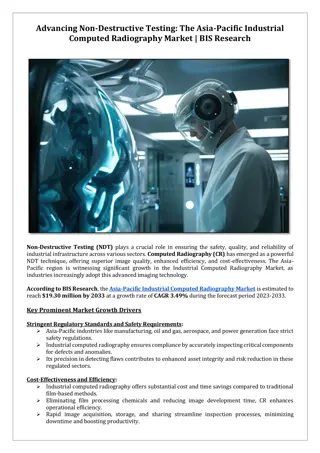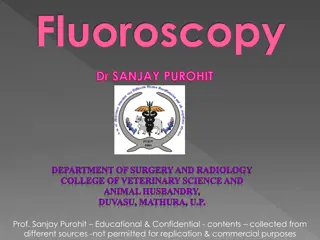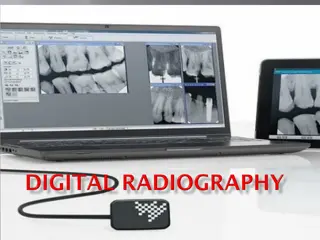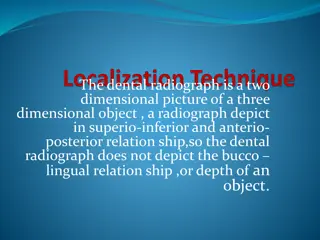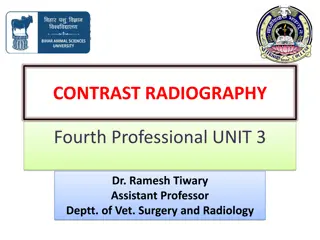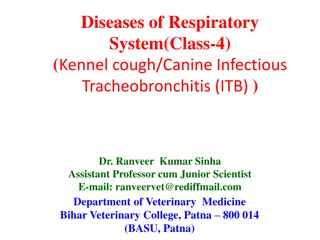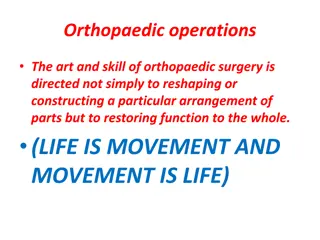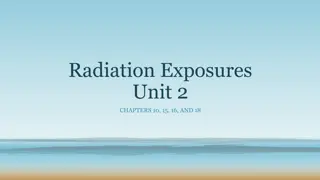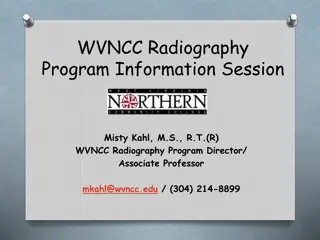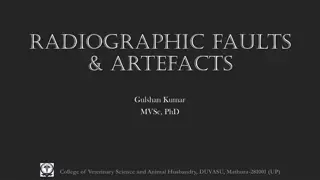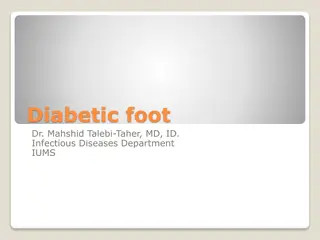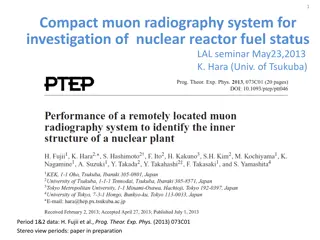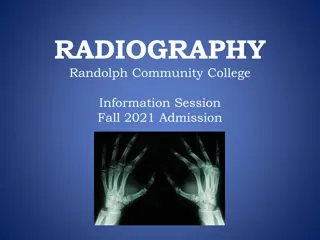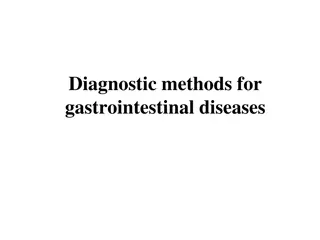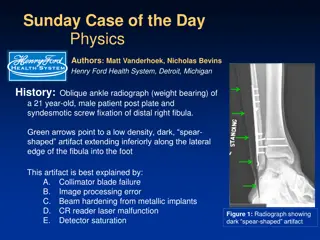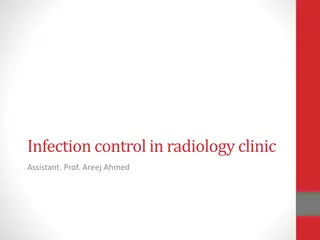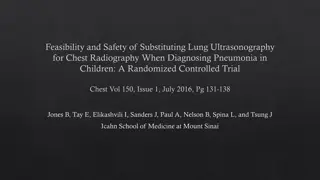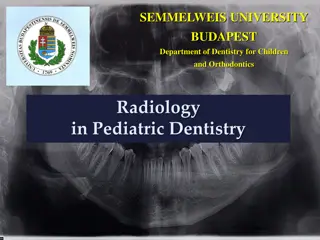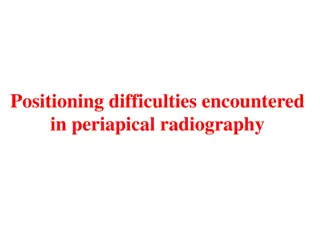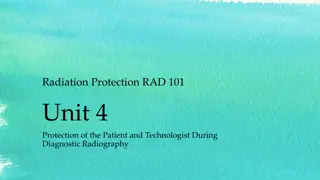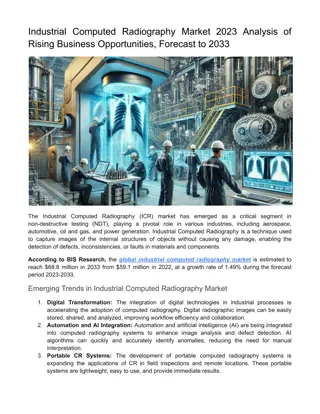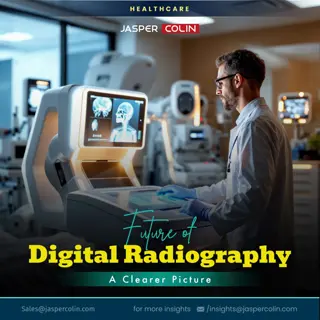Evolution of Digital Radiography in Medical Imaging
Explore the evolution of digital radiography in medical imaging, from the invention of CMOS in 1963 to the development of Gadolinium-based flat-panel detectors in 1997. Learn about the advantages and challenges of digital imaging technology and its impact on the field of radiography.
0 views • 102 slides
Chest Imaging Interpretation for Tuberculosis Screening
Chest imaging plays a crucial role in screening for pulmonary tuberculosis (TB). This activity, led by Dana Kissner from Wayne State University Detroit Tuberculosis Clinic, focuses on interpreting chest imaging results to aid in the diagnosis and management of TB cases. The content includes informat
3 views • 22 slides
Advancing Non-Destructive Testing: The APAC Industrial Computed Radiography
According to BIS Research, the Asia-Pacific Industrial Computed Radiography Market is estimated to reach $19.30 million by 2033 at a growth rate of CAGR 3.49% during the forecast period 2023-2033.
1 views • 3 slides
Radiographic Imaging Methods of the Respiratory System
Radiographic imaging plays a crucial role in the evaluation and diagnosis of thoraco-mediastino-pleuro-pulmonary conditions. Techniques like radioscopy, digital radiography, computer tomography, magnetic resonance imaging, conventional pulmonary angiography, and hybrid imaging methods offer detailed
10 views • 21 slides
SALIVARY GLAND IMAGING
Salivary gland imaging plays a crucial role in diagnosing and monitoring diseases of the major salivary glands, including the parotid, submandibular, and sublingual glands. Different imaging techniques such as computed tomography, MRI, and ultrasound are used to visualize these glands and aid in dif
1 views • 12 slides
Understanding Fluoroscopy in Veterinary Radiology
Fluoroscopy is a dynamic radiographic examination primarily managed by radiologists, with radiographers assisting in routine post-fluoroscopic radiography. The equipment involved includes X-ray tubes, C-arms, and image intensification tubes, which play crucial roles in enhancing image brightness and
0 views • 51 slides
Understanding Digital Radiography in Modern Healthcare
Digital radiography revolutionizes imaging by capturing, displaying, and storing radiographic images digitally, offering benefits such as dose reduction, image manipulation, and electronic transfer. While there are advantages like environmentally friendliness, it also comes with challenges like high
0 views • 25 slides
Localization Techniques in Dental Radiography: Enhancing Depth Perception
Dental radiographs, though two-dimensional, can be limited in depicting depth and bucco-lingual relationships. Localization techniques like the right angle and tube-shift methods are used to accurately locate objects such as foreign bodies, impacted or unerupted teeth, and salivary stones within the
0 views • 12 slides
Understanding Contrast Radiography in Veterinary Surgery and Radiology
Contrast radiography is a crucial technique in veterinary medicine that involves using contrast media to enhance visualization of organs and lesions. Different types of contrast media, positive and negative, are used to alter tissue radio density for better demarcation. Barium and iodine compounds a
0 views • 14 slides
Kennel Cough: Contagious Canine Respiratory Disease Overview
Kennel Cough, known as Canine Infectious Tracheobronchitis, is a highly contagious respiratory disease affecting dogs, characterized by acute tracheobronchitis and a paroxysmal cough lasting several days. It is caused by various infectious agents, including Canine Parainfluenza Virus and Bordetella
0 views • 12 slides
The Art of Orthopaedic Surgery: A Comprehensive Guide
Orthopaedic surgery involves intricate planning, precise execution, and specialized equipment to restore function to the body. From preoperative assessments to intraoperative techniques like radiography and magnification, this field aims to enhance mobility and quality of life. The use of tourniquet
0 views • 22 slides
Understanding Grid Types in Imaging Technology
Explore different types of grids used in imaging technology such as Parallel, Crossed, Focused, and Moving Grid (Potter-Bucky). Learn about their advantages, disadvantages, and specific applications in radiography. The visual representations and detailed descriptions provide insights into how these
0 views • 11 slides
Understanding Filtration in Radiography
Filtration is a crucial process in radiography that involves eliminating undesirable low-energy photons to enhance image quality and reduce radiation dose to patients. This process involves using filters made of materials like aluminum to selectively absorb photons. Measurement of filtration is expr
0 views • 63 slides
Radiography Program Information at WVNCC: Overview and Application Process
WVNCC Radiography Program offers an A.A.S. Degree in Radiography at its Wheeling Campus. The program is accredited by JRCERT and boasts 12 diverse Clinical Education Sites. Learn about the selective application process, interview pointers, conditional acceptance criteria, and potential career opport
0 views • 8 slides
Understanding Radiographic Faults and Artefacts in Veterinary Imaging
Learn about radiographic faults and artefacts in veterinary radiography, including technical errors like motion artefacts, dark radiographs, gray non-contrast images, and light radiographs, as well as processing errors such as dark spots and white spots on radiographs. Discover the causes of these e
0 views • 12 slides
Understanding the Diabetic Foot: Stages, Assessment, and Management
Explore the natural history of the diabetic foot, from initial stages to potential complications like ulcers and infections. Learn about the assessment of ulcerated feet, including identifying signs of infection and necrosis. Discover the role of radiography and microbiological control in managing d
0 views • 51 slides
Compact Muon Radiography System for Investigation of Nuclear Reactor Fuel Status
A seminar presentation at LAL on May 23, 2013, discussed a compact muon radiography system designed for investigating the status of nuclear reactor fuel. The system, developed by researchers from the University of Tsukuba, involved the use of trackers with scintillators and muon detectors at various
0 views • 56 slides
Overview of Radiography and Ultrasound Imaging Techniques
This content provides a comprehensive overview of conventional radiography, digital radiography, and ultrasound imaging techniques. It covers equipment details, safety issues, advantages vs. limitations, as well as the interpretation, magnification, and integration capabilities of these imaging moda
0 views • 28 slides
Radiography Randolph Community College Fall 2021 Admission Information Session
Learn about the admission process for the Radiography program at Randolph Community College for Fall 2021. Complete general admission requirements, provide necessary documents, and attend information sessions. Submit required forms and maintain a minimum GPA. Get all details for Phase I and Phase II
0 views • 18 slides
Diagnostic Methods for Gastrointestinal Diseases: A Comprehensive Overview
Explore various diagnostic methods for gastrointestinal diseases, including laboratory investigations, abdominal ultrasound features, and radiology techniques. Learn about the significance of different tests such as ESR, blood count, liver tests, and abdominal ultrasound in diagnosing conditions aff
0 views • 40 slides
Understanding Image Processing Artifacts in Radiography
An oblique ankle radiograph of a patient showed a dark spear-shaped artifact extending from the leg to the foot, which was identified as an image processing error due to a black border imaging algorithm issue. The presence of metal in the leg caused the algorithm to fail, resulting in the artifact.
0 views • 4 slides
Radiographic Infection Control in Dental Clinics
In dental radiology clinics, infection control is crucial to prevent cross-contamination and disease transmission among patients and staff. Key steps include applying standard precautions, wearing personal protective equipment, disinfecting equipment, and preventing contamination of processing equip
0 views • 16 slides
Utility of Lung Ultrasonography in Pediatric Pneumonia Diagnosis
Pneumonia, a leading cause of pediatric mortality globally, presents diagnostic challenges as history and physical exams may not reliably differentiate viral lung infections from bacterial pneumonia. This study explores the feasibility and safety of substituting lung ultrasonography (LUS) for chest
0 views • 21 slides
Comprehensive Overview of Radiology in Pediatric Dentistry at Semmelweis University Budapest
Radiology plays a crucial role in diagnosing and treating diseases within the body, especially in pediatric dentistry at Semmelweis University Budapest. From the historical evolution of radiography to the modern radiologic diagnostic imaging techniques used in dentistry, this department utilizes a r
1 views • 40 slides
Casting Inspection Methods and Techniques
Various methods such as visual inspection, sound test, impact test, pressure test, radiography, and magnetic particle testing are used for inspecting castings to detect defects like blow holes, cracks, mismatches, and discontinuities. Each method serves a specific purpose in evaluating the quality o
0 views • 15 slides
Challenges and Solutions in Periapical Radiography Techniques
Placement difficulties in periapical radiography can arise due to edentulous ridges and endodontic procedures. Solutions include using the parallel technique and accurate root canal measurements.
0 views • 21 slides
Radiation Protection in Diagnostic Radiography: Patient and Technologist Safety
Effective communication, immobilization, beam-limiting devices, beam filtration, gonadal shielding, exposure factors, IR combinations, good processing techniques, and reducing repeat radiographs are crucial for minimizing patient exposure during radiographic procedures. Equipment design features for
0 views • 49 slides
Industrial Computed Radiography Market
The global industrial computed radiography market is estimated to reach $68.8 million in 2033 from $59.1 million in 2022, at a growth rate of 1.49% during the forecast period 2023-2033.\n\nRead Report Overview: \/\/bisresearch.com\/industry-report\/i
1 views • 3 slides
Future of Digital Radiography- A Clearer Picture
AI and Machine Learning are revolutionizing digital radiography, enabling faster image analysis and early disease detection.
3 views • 9 slides


